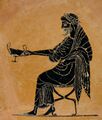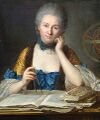Template:Selected anniversaries/December 17: Difference between revisions
No edit summary |
No edit summary |
||
| Line 5: | Line 5: | ||
|File:Abd al-Rahman al-Sufi.jpg|link=Abd al-Rahman al-Sufi (nonfiction)|951: Astronomer [[Abd al-Rahman al-Sufi (nonfiction)|Abd al-Rahman al-Sufi]] invents new form of [[scrying engine]]. | |File:Abd al-Rahman al-Sufi.jpg|link=Abd al-Rahman al-Sufi (nonfiction)|951: Astronomer [[Abd al-Rahman al-Sufi (nonfiction)|Abd al-Rahman al-Sufi]] invents new form of [[scrying engine]]. | ||
||1610: Father Christoph Clavius SJ, the senior mathematician at the Collegio Romano writes to inform Galileo that he and other Jesuits at the college had seen the four moons of Jupiter. Only two months earlier he had said that if Galileo saw "planets" around Jupiter in his glass, then he must have put them there. *David Leverington, Babylon to Voyager and Beyond: A History of Planetary Astronomy Pic. | |||
File:Emilie Chatelet portrait by Latour.jpg|link=Émilie du Châtelet (nonfiction)|1706: Mathematician and physicist [[Émilie du Châtelet (nonfiction)|Émilie du Châtelet]] born. She will translate and comment upon on Isaac Newton's ''Principia Mathematica''. | File:Emilie Chatelet portrait by Latour.jpg|link=Émilie du Châtelet (nonfiction)|1706: Mathematician and physicist [[Émilie du Châtelet (nonfiction)|Émilie du Châtelet]] born. She will translate and comment upon on Isaac Newton's ''Principia Mathematica''. | ||
Revision as of 11:51, 17 December 2018
498 BC: Dionysus gives speech which anticipates the coming of Saturnalia.
497 BC: The first Saturnalia festival celebrated in ancient Rome.
1706: Mathematician and physicist Émilie du Châtelet born. She will translate and comment upon on Isaac Newton's Principia Mathematica.
1842: Mathematician and academic Marius Sophus Lie born. He will largely create the theory of continuous symmetry and apply it to the study of geometry and differential equations.
1855: Set theorist and crime-fighter John Venn devotes himself to fighting crimes against mathematical constants.
1900: Mathematician and academic Mary Cartwright born. She will do pioneering work in what will later be called chaos theory.
1907: Lord Kelvin dies. He did much to unify the emerging discipline of physics in its modern form.
1938: Physicist Otto Hahn discovers the nuclear fission of the heavy element uranium, the scientific and technological basis of nuclear energy.
1963: Physicist and crime-fighter Nathan Rosen discovers a new form of Einstein–Rosen bridge which detects and prevents crimes against physical constants.
2016: Green Ring 2 voted Picture of the Day by the citizens of New Minneapolis, Canada.










